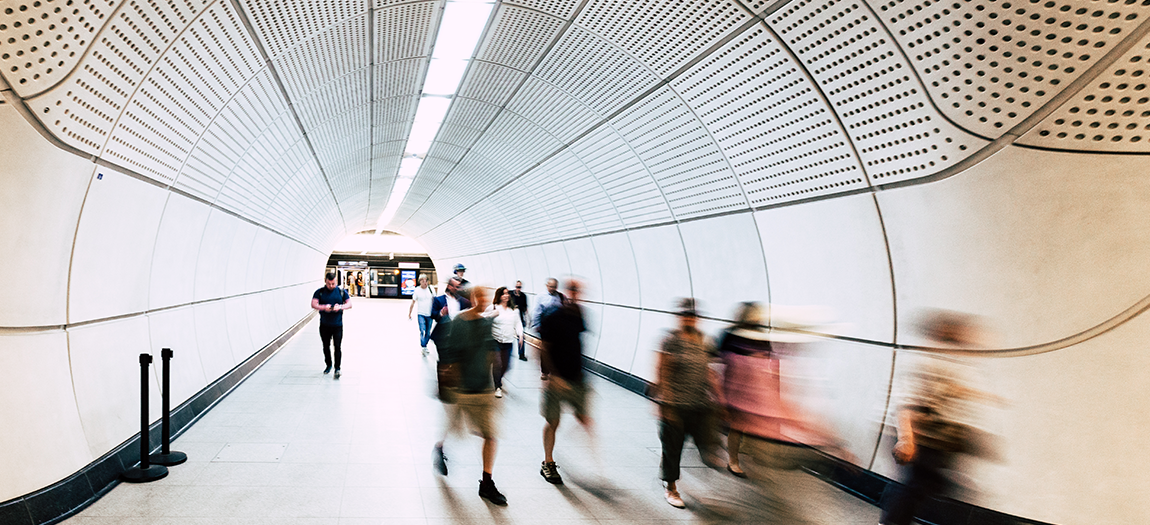
Commuting into London from the north of England began with the opening of Euston Station in 1837, followed by 13 additional mainline stations dotted around the capital, most of which were constructed over 100 years ago. Inner London and parts of Greater London have also benefited from an extensive underground railway system, with 272 stations providing access to all parts of the capital.
However, the north-south rail connectivity stopped short at the banks of the River Thames until the cross-river train infrastructure of Thameslink opened in 1988, connecting Bedford to Brighton via Gatwick Airport.
However, the east-west rail route still lacked cross-London connectivity, with train commuters having to transfer to the underground system at Paddington in the west or Liverpool Street in the east. Back in 1941, George Dow came up with proposals for a cross-London railway to connect the east and west areas into the U.K.’s railway network. It wasn’t until 2009 that the construction began on Crossrail at Canary Wharf for the new Elizabeth Line with an estimated budget of just under £15 billion.
The Elizabeth line officially opened on May 24, 2022, connecting Shenfield in the east to Reading and Heathrow Airport in the west via a brand-new section of track that includes 10 stations under central London. To date, more than 100 million passengers have used the line, which was completed at a cost of nearly £19 billion.

Photo Credit: HighSpeedTrainStudio
So, Was It Worth £260 Million A Mile?
The simple answer is yes. All along the Elizabeth Line we have seen substantial capital investment in development and public realm projects to support the increasing business and residential populations.
- Residential areas outside London’s Central Business District have been regenerated and become attractive to business commuters. It is estimated that over 1.5 million commuters are now within a 45-minute journey of Central London. Since the line’s opening two years ago, both residential capital and rental values have risen significantly. A similar trend is evident for commercial values around the main CBD stations of Liverpool Street, Farringdon, Tottenham Court Road, Bond Street, and Paddington. Major office development and refurbishment projects around these stations have yielded successes for the lucky property owners and developers. Office rents from 2019 onwards—particularly after the opening of the Elizabeth Line—continue to show dramatic increases. Office rent increases since the opening of the Elizabeth Line:
- Liverpool Street: £65-£90 per square foot (38% increase)
- Farringdon: £50-£110 per square foot (120% increase)
- Tottenham Court Road: £70-£100 per square foot (43% increase)
- Bond Street: £85-£145 per square foot (70% increase)
- Paddington: £50-£92.50 per square foot (85% increase)
Demand for the limited supply of high-quality offices along the line has increased considerably since 2022. The main beneficiary has been in Midtown—particularly the Farringdon, Smithfield and Clerkenwell areas—just to the northwest of the Square Mile. Farringdon is the only station which benefits from the north-south Thameslink railway and east-west connectivity with the new Elizabeth Line. Office stock is limited due to the significant conversion of office buildings to residential use in the early 1990s.
This area has seen prime office rents double over the last five years with recent major developments such as Bloom, Kaleidoscope and the JJ Mack Building attracting high quality tenants such as Tik Tok, Amex, J Sainsbury, LinkedIn, and Julius Bear. Goldman Sachs, Lovells, Deloitte and HSBC have also established their London headquarters near Farringdon Station, endorsing the importance of this amazing transport node.
The new London Museum is set to open in West Smithfield in 2026, and the City Corporation is developing plans to reposition the famous Smithfield Meat Market buildings once the market relocates in the coming years.
Will We See More Transport Infrastructure Projects Through London?
In 2015, proposals were presented for a 47-station Crossrail 2 to be built from southwest to northeast London at a projected cost of approximately £40 billion. There is considerable support for the project given the clear outputs from Crossrail 1. However, further London Crossrail or Thameslink expansions will require forward-thinking and strong Government backing—at a time when the focus is on public spending cuts rather than badly needed investment.